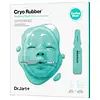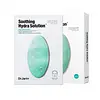Dr. Jart+ Cryo Rubber Face Mask Versus Dr. Jart+ Dermask™ Water Jet Soothing Hydra Solution Face Mask
What's inside
What's inside
 Key Ingredients
Key Ingredients

 Benefits
Benefits

 Concerns
Concerns

 Ingredients Side-by-side
Ingredients Side-by-side

Water
Skin ConditioningDipropylene Glycol
HumectantGlycerin
HumectantCaprylic/Capric Triglyceride
MaskingButylene Glycol
HumectantNiacinamide
Smoothing1,2-Hexanediol
Skin ConditioningPEG-240/Hdi Copolymer Bis-Decyltetradeceth-20 Ether
StabilisingGlyceryl Stearate
EmollientPEG-100 Stearate
Dimethicone
EmollientGlycereth-26
HumectantHydroxyethyl Acrylate/Sodium Acryloyldimethyl Taurate Copolymer
Emulsion StabilisingIsohexadecane
EmollientAllantoin
Skin ConditioningTrehalose
HumectantGlyceryl Acrylate/Acrylic Acid Copolymer
HumectantEthylhexylglycerin
Skin ConditioningBetaine
HumectantDisodium EDTA
Polysorbate 60
EmulsifyingSorbitan Isostearate
EmulsifyingMelia Azadirachta Leaf Extract
Skin ConditioningMelia Azadirachta Flower Extract
Skin ConditioningTocopherol
AntioxidantPotassium Laurate
EmulsifyingMacadamia Ternifolia Seed Oil
EmollientMangifera Indica Seed Butter
Skin ConditioningSorbitan Sesquioleate
EmulsifyingCetyl Alcohol
EmollientStearyl Alcohol
EmollientAllium Cepa Bulb Extract
Skin ConditioningAsparagus Officinalis Extract
Skin ConditioningBrassica Oleracea Capitata Leaf Extract
Skin ConditioningCynara Scolymus Leaf Extract
Skin ConditioningMusa Sapientum Fruit Extract
Skin ConditioningUndaria Pinnatifida Extract
Skin ConditioningMethylpropanediol
SolventChondrus Crispus Extract
Skin ConditioningCeratonia Siliqua Gum
EmollientPotassium Chloride
Xanthan Gum
EmulsifyingHydroxyacetophenone
AntioxidantSucrose
HumectantCaprylyl Glycol
EmollientAlgin
MaskingPanthenol
Skin ConditioningPolyglyceryl-10 Laurate
Skin ConditioningCI 77891
Cosmetic ColorantCalcium Chloride
AstringentDipotassium Glycyrrhizate
HumectantCoccinia Indica Fruit Extract
Skin ConditioningSodium Citrate
BufferingAloe Barbadensis Flower Extract
EmollientSolanum Melongena Fruit Extract
Skin ConditioningCitric Acid
BufferingXylitylglucoside
HumectantOcimum Sanctum Leaf Extract
Skin ConditioningAnhydroxylitol
HumectantCorallina Officinalis Extract
Skin ConditioningCurcuma Longa Root Extract
MaskingXylitol
HumectantCentella Asiatica Extract
CleansingGlucose
HumectantHydrogen Dimethicone
Diatomaceous Earth
AbrasiveKaolin
AbrasiveWater, Dipropylene Glycol, Glycerin, Caprylic/Capric Triglyceride, Butylene Glycol, Niacinamide, 1,2-Hexanediol, PEG-240/Hdi Copolymer Bis-Decyltetradeceth-20 Ether, Glyceryl Stearate, PEG-100 Stearate, Dimethicone, Glycereth-26, Hydroxyethyl Acrylate/Sodium Acryloyldimethyl Taurate Copolymer, Isohexadecane, Allantoin, Trehalose, Glyceryl Acrylate/Acrylic Acid Copolymer, Ethylhexylglycerin, Betaine, Disodium EDTA, Polysorbate 60, Sorbitan Isostearate, Melia Azadirachta Leaf Extract, Melia Azadirachta Flower Extract, Tocopherol, Potassium Laurate, Macadamia Ternifolia Seed Oil, Mangifera Indica Seed Butter, Sorbitan Sesquioleate, Cetyl Alcohol, Stearyl Alcohol, Allium Cepa Bulb Extract, Asparagus Officinalis Extract, Brassica Oleracea Capitata Leaf Extract, Cynara Scolymus Leaf Extract, Musa Sapientum Fruit Extract, Undaria Pinnatifida Extract, Methylpropanediol, Chondrus Crispus Extract, Ceratonia Siliqua Gum, Potassium Chloride, Xanthan Gum, Hydroxyacetophenone, Sucrose, Caprylyl Glycol, Algin, Panthenol, Polyglyceryl-10 Laurate, CI 77891, Calcium Chloride, Dipotassium Glycyrrhizate, Coccinia Indica Fruit Extract, Sodium Citrate, Aloe Barbadensis Flower Extract, Solanum Melongena Fruit Extract, Citric Acid, Xylitylglucoside, Ocimum Sanctum Leaf Extract, Anhydroxylitol, Corallina Officinalis Extract, Curcuma Longa Root Extract, Xylitol, Centella Asiatica Extract, Glucose, Hydrogen Dimethicone, Diatomaceous Earth, Kaolin
Water
Skin ConditioningGlycerin
HumectantButylene Glycol
HumectantAlcohol
AntimicrobialPanthenol
Skin ConditioningBetaine
HumectantXylitylglucoside
HumectantAnhydroxylitol
HumectantXylitol
HumectantAloe Barbadensis Leaf Extract
EmollientBambusa Vulgaris Extract
Skin ConditioningPinus Densiflora Leaf Extract
AntimicrobialThuja Orientalis Extract
AntimicrobialChamaecyparis Obtusa Leaf Extract
Skin ConditioningChlorphenesin
AntimicrobialHydroxyethylcellulose
Emulsion StabilisingDisodium EDTA
Xanthan Gum
EmulsifyingPEG-60 Hydrogenated Castor Oil
EmulsifyingGlycyrrhiza Glabra Root Extract
BleachingZingiber Officinale Root Extract
MaskingSchisandra Chinensis Fruit Extract
Skin ConditioningCoptis Japonica Root Extract
Skin ConditioningCamellia Sinensis Leaf Extract
AntimicrobialCaprylyl Glycol
Emollient1,2-Hexanediol
Skin ConditioningDipotassium Glycyrrhizate
HumectantHydroxyethyl Acrylate/Sodium Acryloyldimethyl Taurate Copolymer
Emulsion StabilisingCarbomer
Emulsion StabilisingArginine
MaskingCitrus Grandis Seed Extract
AstringentAcorus Calamus Root Extract
PerfumingPerilla Ocymoides Leaf Extract
TonicCyclopentasiloxane
EmollientCyclohexasiloxane
EmollientPEG-10 Dimethicone/Vinyl Dimethicone Crosspolymer
StabilisingPolyglutamic Acid
Skin ConditioningMethylpropanediol
SolventPhenoxyethanol
PreservativeThymus Vulgaris Flower/Leaf Oil
MaskingWater, Glycerin, Butylene Glycol, Alcohol, Panthenol, Betaine, Xylitylglucoside, Anhydroxylitol, Xylitol, Aloe Barbadensis Leaf Extract, Bambusa Vulgaris Extract, Pinus Densiflora Leaf Extract, Thuja Orientalis Extract, Chamaecyparis Obtusa Leaf Extract, Chlorphenesin, Hydroxyethylcellulose, Disodium EDTA, Xanthan Gum, PEG-60 Hydrogenated Castor Oil, Glycyrrhiza Glabra Root Extract, Zingiber Officinale Root Extract, Schisandra Chinensis Fruit Extract, Coptis Japonica Root Extract, Camellia Sinensis Leaf Extract, Caprylyl Glycol, 1,2-Hexanediol, Dipotassium Glycyrrhizate, Hydroxyethyl Acrylate/Sodium Acryloyldimethyl Taurate Copolymer, Carbomer, Arginine, Citrus Grandis Seed Extract, Acorus Calamus Root Extract, Perilla Ocymoides Leaf Extract, Cyclopentasiloxane, Cyclohexasiloxane, PEG-10 Dimethicone/Vinyl Dimethicone Crosspolymer, Polyglutamic Acid, Methylpropanediol, Phenoxyethanol, Thymus Vulgaris Flower/Leaf Oil
 Reviews
Reviews

Ingredients Explained
These ingredients are found in both products.
Ingredients higher up in an ingredient list are typically present in a larger amount.
1,2-Hexanediol is a synthetic liquid and another multi-functional powerhouse.
It is a:
- Humectant, drawing moisture into the skin
- Emollient, helping to soften skin
- Solvent, dispersing and stabilizing formulas
- Preservative booster, enhancing the antimicrobial activity of other preservatives
This ingredient is created from dehydrating xylitol in acidic conditions. Xylitol is a famous sugar and humectant.
Much like its predecessor, anhydroxylitol is a humectant. Humectants attract and hold water to moisturize the skin.
This ingredient is most commonly found in a popular trio called Aquaxyl. Aquaxyl is made up of anhydroxylitol (24 - 34%), xylitylglucoside (35 - 50%), and xylitol (5 - 15%).
According to a manufacturer, Aquaxyl is known for a 3-D hydration concept and an anti-dehydration shield to reinforce the outer layer of skin.
This ingredient is often derived from plants such as wood and sugarcane.
Learn more about AnhydroxylitolBetaine is a common humectant (a substance that promotes retention of moisture). It's known to be gentle on the skin and can help balance hydration.
This ingredient is best for improving hydration and soothing irritated skin. Studies also show it helps even out skin tone.
Fun fact: Betaine is naturally created in the skin and body. The kind found within cosmetic products can be either plant-derived or synthetic.
Another name for betaine is trimethylglycine.
Learn more about BetaineButylene Glycol (or BG) is used within cosmetic products for a few different reasons:
Overall, Butylene Glycol is a safe and well-rounded ingredient that works well with other ingredients.
Though this ingredient works well with most skin types, some people with sensitive skin may experience a reaction such as allergic rashes, closed comedones, or itchiness.
Learn more about Butylene GlycolCaprylyl Glycol is a humectant and emollient, meaning it attracts and preserves moisture.
It is a common ingredient in many products, especially those designed to hydrate skin. The primary benefits are retaining moisture, skin softening, and promoting a healthy skin barrier.
Though Caprylyl Glycol is an alcohol derived from fatty acids, it is not the kind that can dry out skin.
This ingredient is also used as a preservative to extend the life of products. It has slight antimicrobial properties.
Learn more about Caprylyl GlycolDipotassium Glycyrrhizate comes from licorice root.
Extracts of licorice have demonstrated to have antibacterial, anti‐inflammatory, antiviral, antioxidant properties.
One component, glabridin, has extra potent antioxidant and soothing properties. It has also been found to block pigmentation from UVB rays in guinea pigs.
Licorice Root also contains a flavonoid. Flavonoids are a natural substance from in plants. Flavonoids also have antioxidant properties.
Another component, glycyrrhizin, has been found to have anti-inflammatory and antimicrobial benefits. This may make licorice root extract effective at treating acne. However, more research is needed to support this.
Liquiritin is one of the flavone compounds found in licorice. It has been found to help lighten skin by preventing tyrosinase from reacting with tyrosine. When the two react, protein is converted to melanin. Melanin is the substance in your body that gives your features pigmentation.
Licorice root is native to Southern Europe and Asia. It has been used in traditional Chinese medicine to help with respiratory issues.
Learn more about Dipotassium GlycyrrhizateDisodium EDTA plays a role in making products more stable by aiding other preservatives.
It is a chelating agent, meaning it neutralizes metal ions that may be found in a product.
Disodium EDTA is a salt of edetic acid and is found to be safe in cosmetic ingredients.
Learn more about Disodium EDTAGlycerin is already naturally found in your skin. It helps moisturize and protect your skin.
A study from 2016 found glycerin to be more effective as a humectant than AHAs and hyaluronic acid.
As a humectant, it helps the skin stay hydrated by pulling moisture to your skin. The low molecular weight of glycerin allows it to pull moisture into the deeper layers of your skin.
Hydrated skin improves your skin barrier; Your skin barrier helps protect against irritants and bacteria.
Glycerin has also been found to have antimicrobial and antiviral properties. Due to these properties, glycerin is often used in wound and burn treatments.
In cosmetics, glycerin is usually derived from plants such as soybean or palm. However, it can also be sourced from animals, such as tallow or animal fat.
This ingredient is organic, colorless, odorless, and non-toxic.
Glycerin is the name for this ingredient in American English. British English uses Glycerol/Glycerine.
Learn more about GlycerinThis is a synthetic polymer. It helps improve the texture of products by adding thickness and gel-like feel.
It is also an emulsifer, meaning it prevents ingredients such as oil and water from separating. It also helps evenly disperse other ingredients.
Methylpropanediol is a synthetic solvent and humectant.
As a solvent, it helps dissolve other ingredients, helping to evenly distribute ingredients throughout the product. This ingredient has also been shown to have antimicrobial properties which makes it a preservative booster.
Methylpropanediol is able to add a bit of moisture to the skin. It also helps other ingredients be better absorbed into the skin, such as salicylic acid.
Learn more about MethylpropanediolPanthenol is a common ingredient that helps hydrate and soothe the skin. It is found naturally in our skin and hair.
There are two forms of panthenol: D and L.
D-panthenol is also known as dexpanthenol. Most cosmetics use dexpanthenol or a mixture of D and L-panthenol.
Panthenol is famous due to its ability to go deeper into the skin's layers. Using this ingredient has numerous pros (and no cons):
Like hyaluronic acid, panthenol is a humectant. Humectants are able to bind and hold large amounts of water to keep skin hydrated.
This ingredient works well for wound healing. It works by increasing tissue in the wound and helps close open wounds.
Once oxidized, panthenol converts to pantothenic acid. Panthothenic acid is found in all living cells.
This ingredient is also referred to as pro-vitamin B5.
Learn more about PanthenolWater. It's the most common cosmetic ingredient of all. You'll usually see it at the top of ingredient lists, meaning that it makes up the largest part of the product.
So why is it so popular? Water most often acts as a solvent - this means that it helps dissolve other ingredients into the formulation.
You'll also recognize water as that liquid we all need to stay alive. If you see this, drink a glass of water. Stay hydrated!
Learn more about WaterXanthan gum is used as a stabilizer and thickener within cosmetic products. It helps give products a sticky, thick feeling - preventing them from being too runny.
On the technical side of things, xanthan gum is a polysaccharide - a combination consisting of multiple sugar molecules bonded together.
Xanthan gum is a pretty common and great ingredient. It is a natural, non-toxic, non-irritating ingredient that is also commonly used in food products.
Learn more about Xanthan GumXylitol is a humectant and prebiotic. It can help with dry skin.
In studies, xylitol has been shown to improve dry skin. It decreased transepidermal water loss, or when water passes through the skin and evaporates. Xylitol also showed to help improve the biomechanical properties of the skin barrier.
The prebiotic property of xylitol may also help reinforce our skin's natural microbiome. Having a healthy microbiome prevents infection by bad bacteria and helps with hydration.
As a humectant, Xylitol helps draw moisture from both the air and from deeper skin layers. This helps keep skin hydrated.
Xylitol is a sugar alcohol and commonly used as a sugar substitute. It is naturally occurring in plants such as strawberries and pumpkin.
Learn more about XylitolXylitylglucoside is created from xylitol and glucose, two humectants.
Not surprisingly, this ingredient is also a humectant. It attracts and holds water in your skin, helping to maintain hydration.
This ingredient is most commonly found in a popular trio called Aquaxyl. Aquaxyl is made up of anhydroxylitol(24 - 34%), xylitylglucoside (35 - 50%), and xylitol (5 - 15%).
According to a manufacturer, Aquaxyl is known for a 3-D hydration concept and an anti-dehydration shield to reinforce the outer layer of skin.
Learn more about Xylitylglucoside